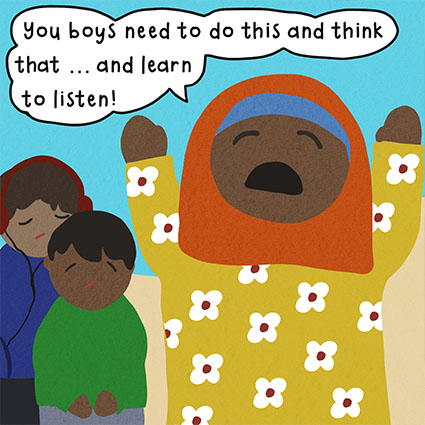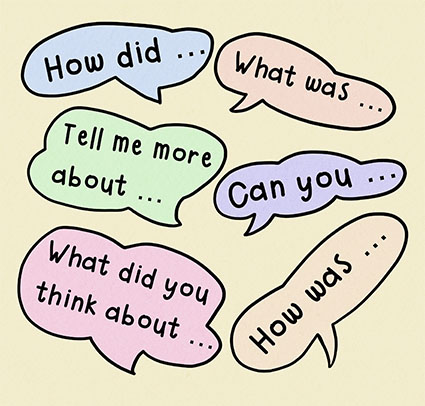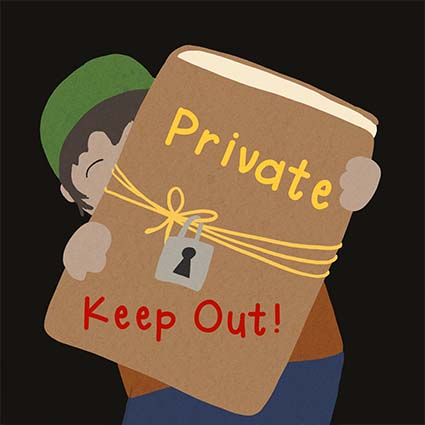Learn How to Listen: Encouraging Your Child or Teen to Open-Up and Talk to You… InShaAllah!

As Muslim parents or as an adult in a child’s life, it is easy to fall into the trap of believing that communicating with our children involves telling them what to do and what to believe. When we finally do ‘listen’ to them, it often involves us merely pausing for breath to allow them to speak until we can jump in again and offer our opinion and advice!
When faced with the responsibility of raising practicing Muslim children, or when confronted by a defiant and contrary teen, it is easy to react by telling them what they should be doing and thinking. Yet in this approach we often overlook the need to consider, listen and try to understand their point of view, especially when we disagree with it!
Learning how to effectively communicate with our children is essential in building a strong relationship with them – it lets them feel heard and understood as well as ultimately
helps them to listen to what we also have to say. It is also one of the most important skills in parenting, and is especially vital for Muslim families raising children living in the West.
There are various skills and techniques involved in communication however ‘Active Listening’ is a foundational skill and one that we as parents can immediately begin to learn and use, to help build an ongoing and lasting relationship with our children, InShaAllah. It is never too late to start!
What is Active Listening?
Active listening is an approach to listening that involves being present with the person speaking, and actively participating in the conversation by using indicators that demonstrate to the person talking, that we are listening and striving to understand what is being said. It encourages the speaker to open-up, elaborate and share what it is they want to talk about. This differs to passive listening whereby the listener is more of an audience, lost in their own thoughts and judgements and simply waiting for a pause in which they can then in turn speak.

How to Show Your Child/Teen that You are listening
Get Rid of Distractions
Nowadays it is common for many of us to have our mobile phone glued to our hands and to talk and listen to our child/teen and vice-a-versa whilst simultaneously reading or sending a message etc. However we cannot properly listen when our attention is on another task. To actively listen we need to be present with our full attention. Therefore when listening to your child/teen ensure that phones, screens and other distractions are either turned off or put away.

If your child is talking to you whilst you are on the phone or sending a text, it communicates to them that what they are saying is not important. They may feel invalidated and decide consciously or unconsciously that you are not interested in them or in what they have to say. Consequently, they may withdraw and avoid coming to talk to you in future. Giving your child/teen etc your undivided attention when they are speaking will allow you to focus on what they are telling you and allow them to feel heard and validated.
We all have busy lives and children may want to speak to you at a time when you have other commitments. If you are unable to speak to them in the moment that they want, then make sure that you reassure them that what they have to say is important to you and that you want to listen to them and give them your full attention. Ask them if it is ok to wait e.g. 15 minutes, so that you can sit down together without any distractions to talk.
Verbal and Non-Verbal Communication
Up to 90% of communication has been found to be non-verbal. When actively listening and talking with your child it is important to read their non-verbal cues such as facial expressions, body language and tone of voice to more accurately understand what it is they are communicating to you. Similarly you can use non-verbal cues to communicate back with them to help them know that you are listening and striving to understand them. A child will pick up on whether you are truly listening or not by reading your body language and will quickly notice if you are yawning, gazing out of the window, or looking agitated as if you want to leave the conversation…

Examples of non-verbal cues include nodding, smiling, use of facial expressions to reflect the emotion of what is being said, open body language such as leaning forward slightly, arms uncrossed, and good eye contact.
Alongside non-verbal cues you can use verbal cues or utterances that can further help convey to your child that you are interested in and empathise with what they are. Examples of verbal cues may include utterances such as ‘mmm’, ‘ahhh I see’, ‘that makes sense’, that’s really interesting’ …etc.
The use of these verbal and non-verbal cues lets your child know that what they have to say matters and is important.

Encouraging Your Child/Teen to Open-Up and Share
It is easy to simply make statements or offer advice when we listen to our child/teen. However, the aim of active listening is to build a trusting relationship and enable our child/teen to open-up to us and share what is on their minds. A couple of techniques we can use to help encourage this are asking the right type of questions and letting them know we understand what they have said.
Asking Open-Ended Questions
Asking open-ended questions is a powerful and effective way of encouraging your child/teen to open-up and share with you. They are questions that require the elaboration of a point or opinion (rather than closed questions that simply require a yes/no or one word response). Open questions will convey to your child/teen that you are interested, listening and want to know more about what they think or have to say.
Examples of some open-ended question starters:
What is it like to …..?
Can you tell me more about ….?
How did you feel when ….?
What was the best thing about ….?
What did you think about…..?
How do you …..?
What do you like/dislike about ….?
Can you explain how …?

Reflecting Back
Reflecting involves reflecting back to your chid/teen what they have said in a concise manner. It shows your child/teen that you have understood what they have been saying to you, and if not, then it offers them the chance to clarify what they are trying to say. Either way, it conveys that you are listening and interested in what they are saying.
To reflect back to your child, aim to highlight and summarise the main point/s they are making. Also try to name the emotional content that is being communicated, even if this is non-verbal e.g. a sad expression or slumped body language.
For Example
Teen: School is really hard, there’s so much work and homework, I keep getting behind. My teacher keeps giving me more work then gets mad at me and keeps shouting.
Parent: It sounds like you’re feeling overwhelmed and stressed by school and your teacher doesn’t understand
Child: I hate school and the stupid rules. It’s boring and the other children are mean.
Parent: School sounds really tough for you and you feel alone

Be Present and Open-Minded
When listening to your child, aim to be emotionally present and with your full attention as well as just physically present. This may take practice especially if our own emotions are triggered. It is also easy to become distracted by our own thoughts, judgements and urge to provide advice.
If, as you listen to your child, you notice your mind wandering, or your inner voice chatting away, just gently guide your attention back to your child. You can always reflect back what they have said and allow them to correct you if you missed anything. But strive to be present and to give your child/teen your undivided attention whilst they are talking. If they are very chatty it is also ok to set a time boundary e.g. let’s still and talk for 20 minutes before I go and prepare lunch etc.
Active listening involves having an open mind to what your child/teen is saying and expressing. Notice when you have a tendency to form an opinion or judgement and try to put it to one side. The aim of active listening is to first understand your child’s/teen’s perspective before going on to formulate your own opinions or conclusions.
When a child/teen feels heard and understood they will then be far more receptive to what you in turn want to say or advise.
Whilst active listening is simple in theory, it can take practice and is something that becomes more intuitive over time. We all get distracted and make judgements but the key is to begin to notice them. By recognising them we can then work on improving our active listening skills, which will help us become more present with our child/teen. Your child/teen in turn will feel more heard, validated and understood and more likely to come to you when they want to discuss difficult matters InShaAllah.

Reflective Exercise
Have a conversation with your child/teen and try to incorporate some of the active listening skills discussed above.
Afterwards, or in your own time, it can help to take some time to reflect on how the conversation and your active listening went – what went well, which skills you used and the response from your child, as well as moments where you may not have been present and areas for further development.
Some Reflection Questions to Think and/or Write About:
♥ Which skills did you manage to practice? Verbal cues; non-verbal cues; open questions; reflecting; being present; non-judgemental; open-minded?
♥ What did you notice about your child in response (e.g. did it encourage them to speak more etc)?
♥ Reflect on your child’s body language and non-verbal cues – what did you notice?
♥ Did you ask any closed (yes/no) questions?
♥ If so, how could you rephase these as open questions for a future discussion.
♥ Did you notice yourself falling into judgements – if so write them down
♥ Did you notice the urge to interrupt and/or offer advice? Reflect further on this and/or write about it in your journal
♥ Try to notice and write down any other barriers or challenges you encountered to listening with your full attention
Other articles you may be intrested in …

coming soon ...
Find Out More Here


